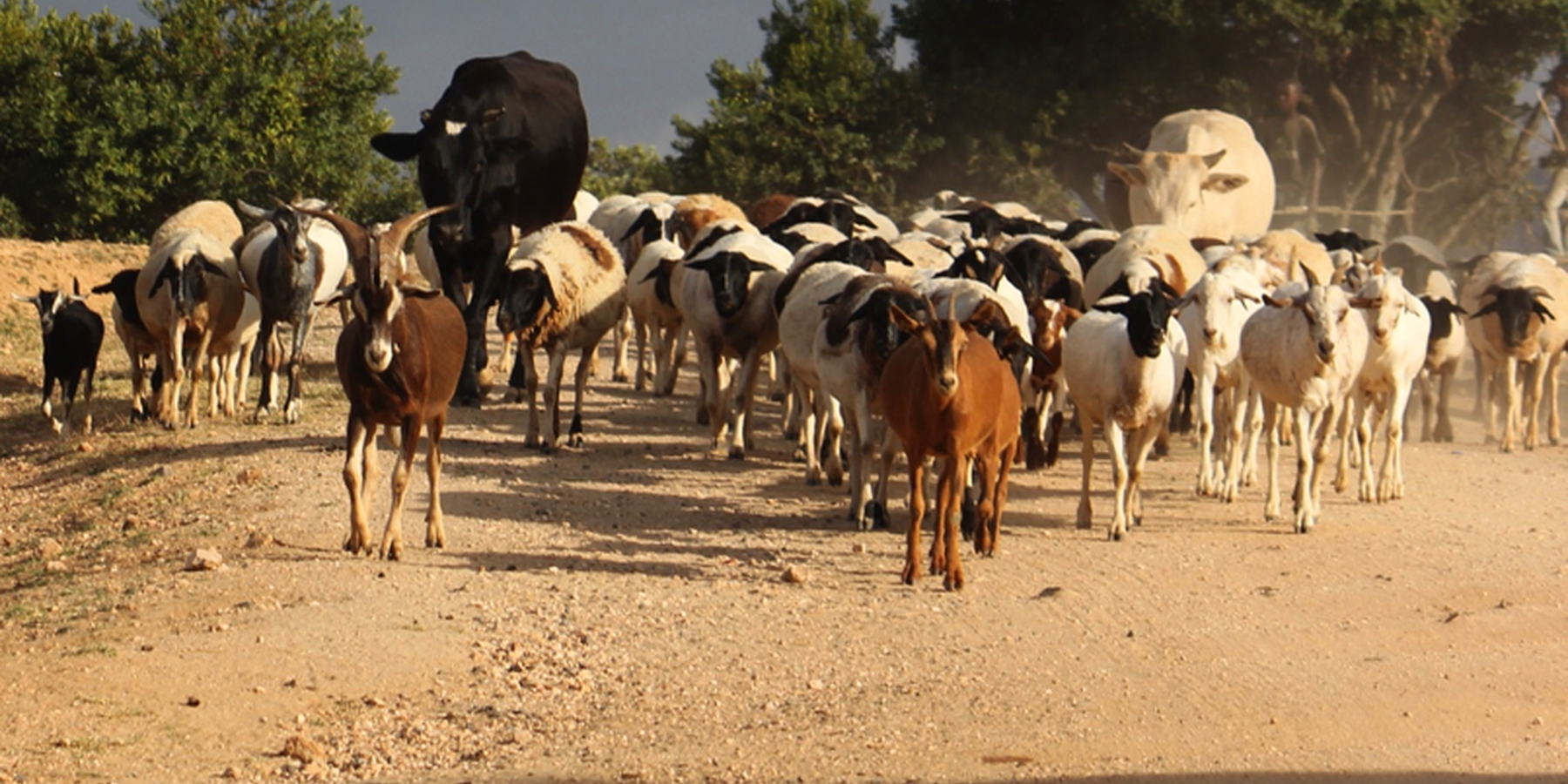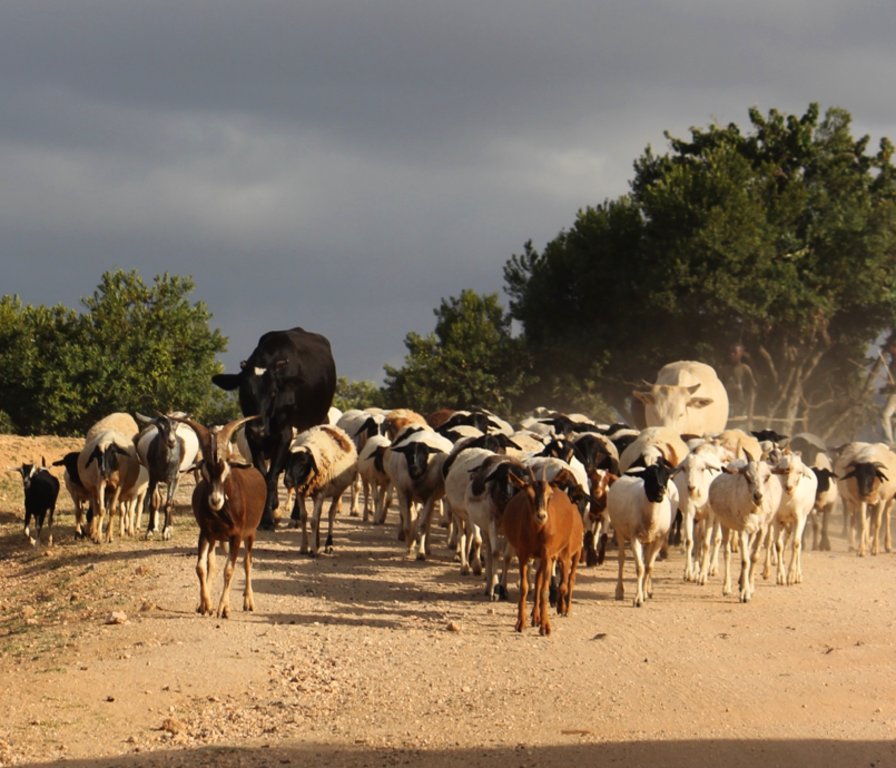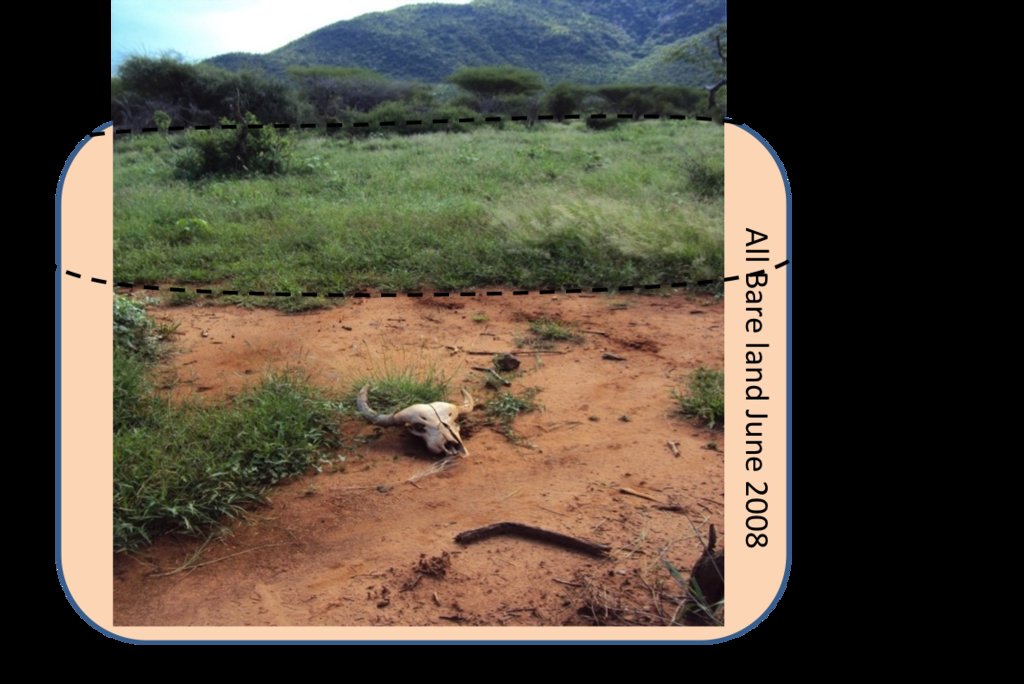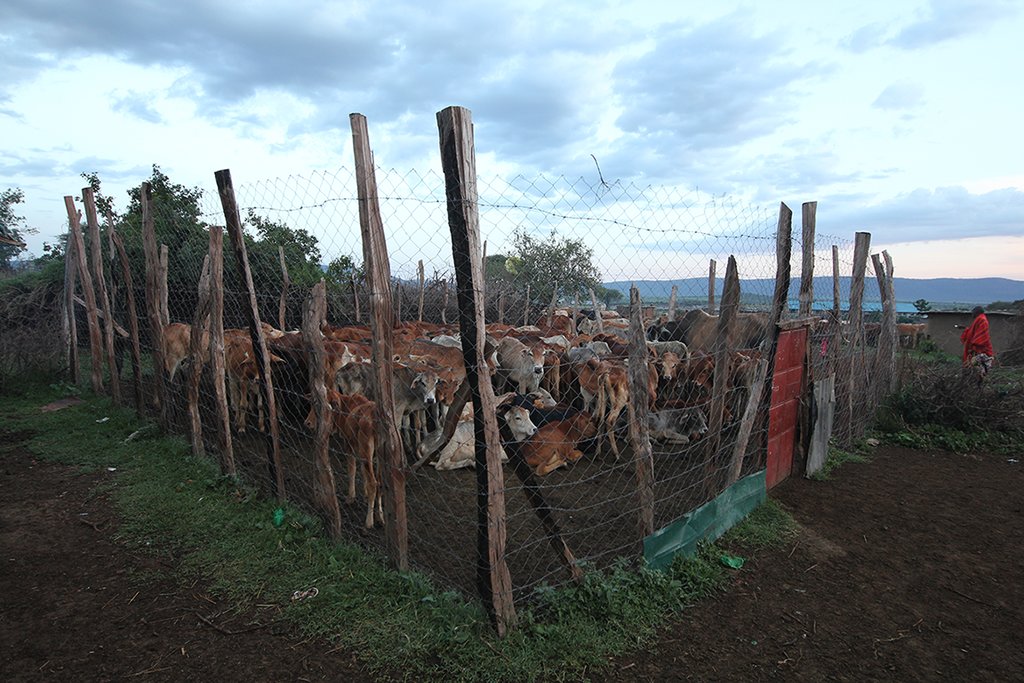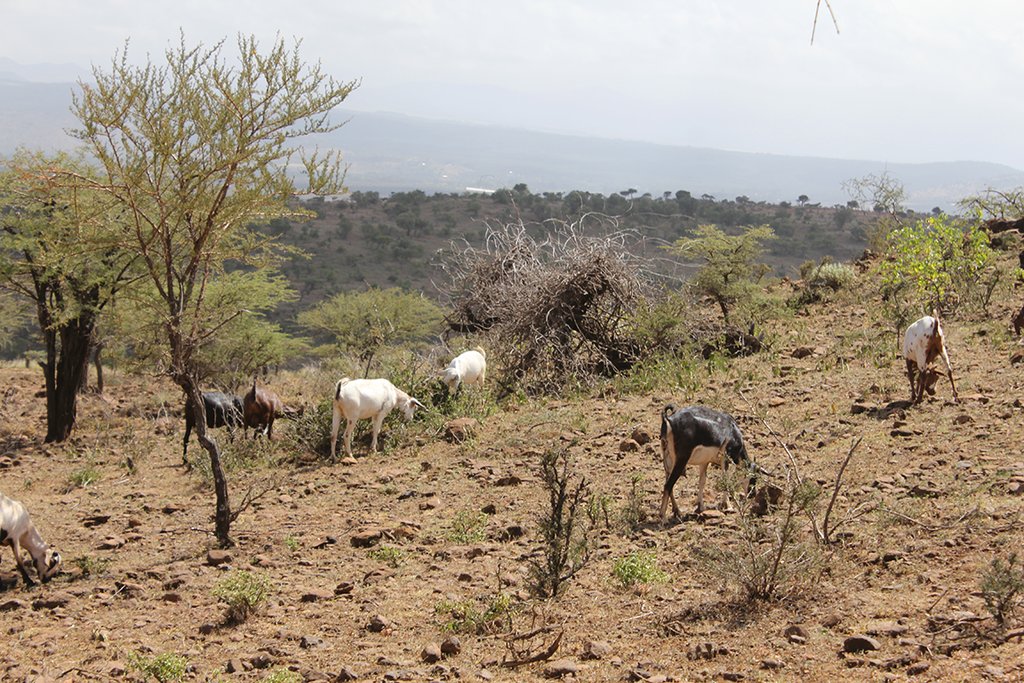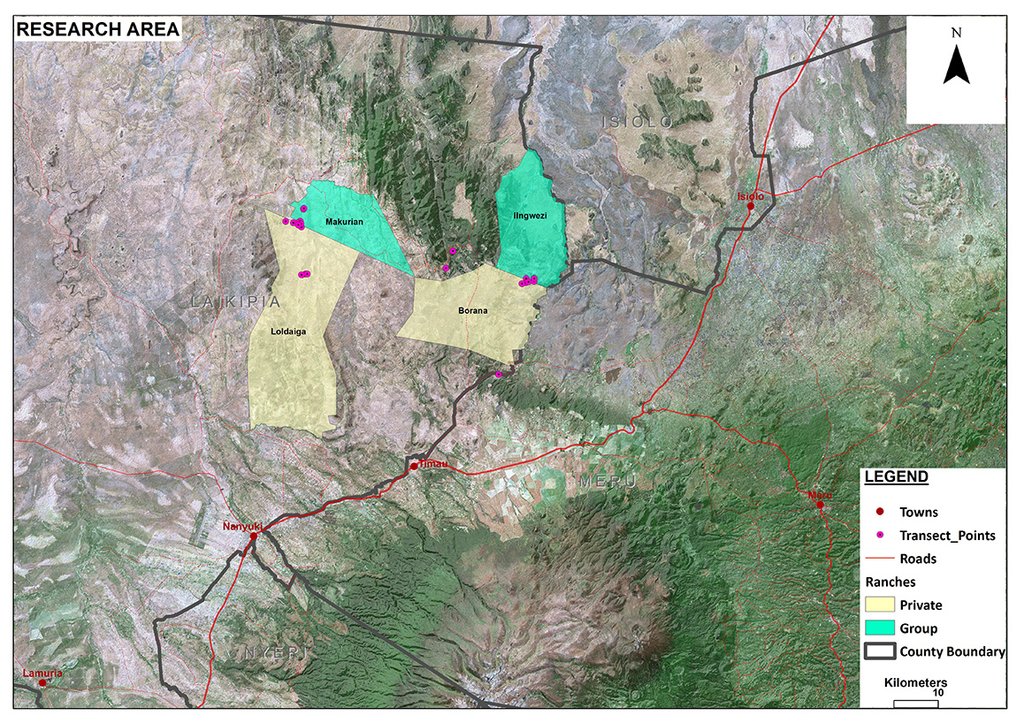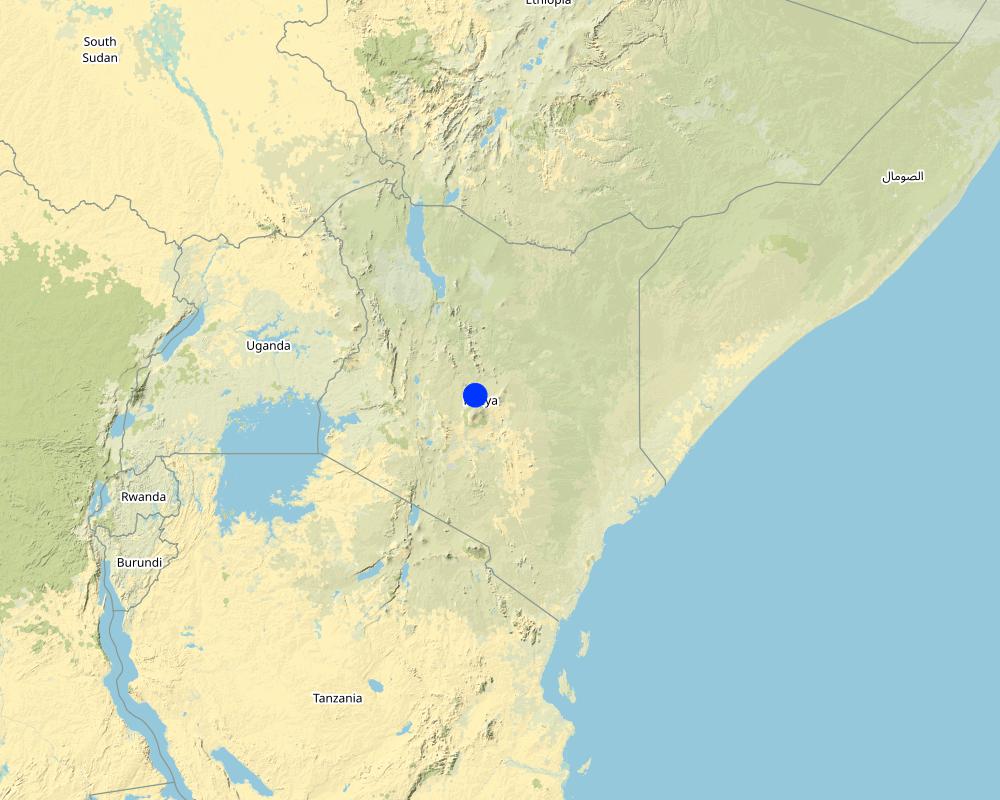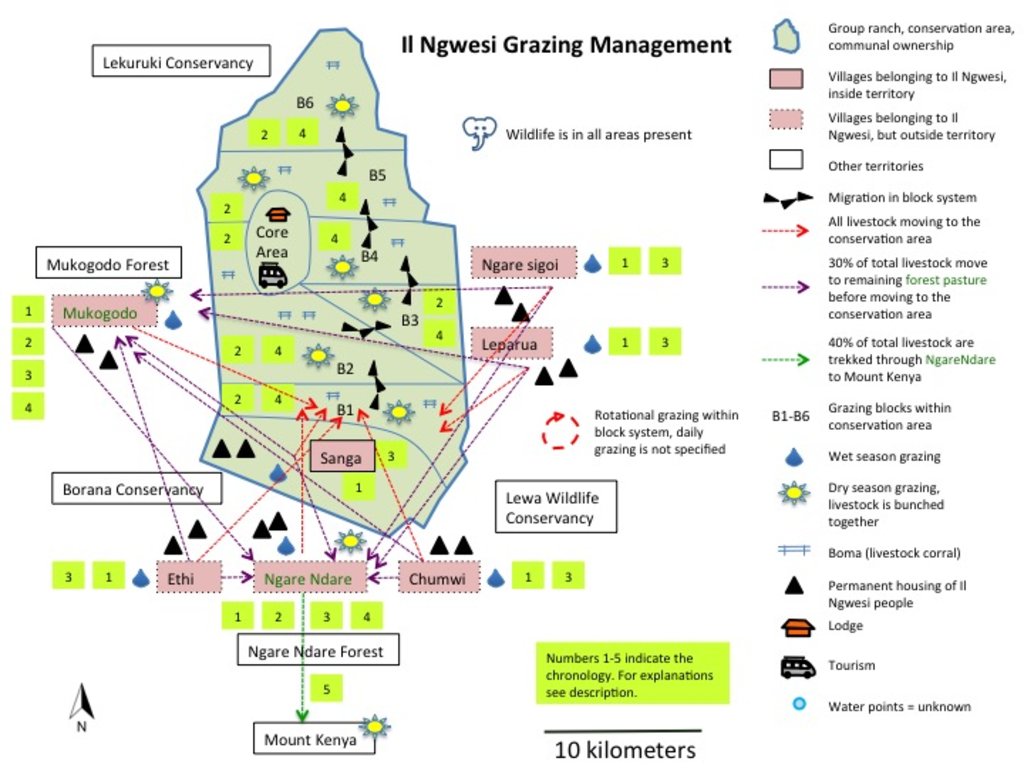Il Ngwesi Group Ranch Grazing with Holistic Management Principles [Quênia]
- Criação:
- Atualização:
- Compilador/a: Michael Herger
- Editor: –
- Revisores: Hanspeter Liniger, Alexandra Gavilano, Rima Mekdaschi Studer, Brigitte Zimmermann, Donia Mühlematter, Joana Eichenberger
technologies_2092 - Quênia
- Resumo completo em PDF
- Resumo completo em PDF para impressão
- Resumo completo no navegador
- Resumo completo (sem formatação)
- Il Ngwesi Group Ranch Grazing with Holistic Management Principles: 4 de Setembro de 2019 (inactive)
- Il Ngwesi Group Ranch Grazing with Holistic Management Principles: 22 de Fevereiro de 2018 (inactive)
- Il Ngwesi Group Ranch Grazing with Holistic Management Principles: 11 de Julho de 2018 (inactive)
- Il Ngwesi Group Ranch Grazing with Holistic Management Principles: 3 de Setembro de 2018 (inactive)
- Il Ngwesi Group Ranch Grazing with Holistic Management Principles: 4 de Outubro de 2018 (inactive)
- Il Ngwesi Group Ranch Grazing with Holistic Management Principles: 2 de Novembro de 2021 (inactive)
- Il Ngwesi Group Ranch Grazing with Holistic Management Principles: 2 de Novembro de 2021 (public)
- Il Ngwesi Group Ranch Grazing with Holistic Management Principles: 1 de Fevereiro de 2018 (inactive)
Veja as seções
Expandir tudo Recolher tudo1. Informação geral
1.2 Detalhes do contato das pessoas capacitadas e instituições envolvidas na avaliação e documentação da tecnologia
Pessoa(s) capacitada(s)
usuário de terra:
Leresi Patrick
Il Ngwesi Group Ranch
Quênia
Nome do projeto que facilitou a documentação/avaliação da Tecnologia (se relevante)
Book project: Guidelines to Rangeland Management in Sub-Saharan Africa (Rangeland Management)1.3 Condições em relação ao uso da informação documentada através de WOCAT
O/a compilador/a e a(s) pessoa(s) capacitada(s) aceitam as condições relativas ao uso de dados documentados através da WOCAT:
Sim
1.4 Declaração de sustentabilidade da tecnologia descrita
A tecnologia descrita aqui é problemática em relação a degradação da terra de forma que não pode ser declarada uma tecnologia de gestão sustentável de terra?
Não
Comentários:
Yes and no, only time will tell here. Grazing principles and management (with partly applied Holistic Managment) of Il Ngwesi Group Ranch are said to be exemplary for group ranches in the area. In evaluation processes since the introduction of the new principles and also in reports, they were rated as "best practice". Land recovery is according to these reports in full swing. However, in the field the picture looks partially different. The land is in large areas (still) heavily degraded. Data suggests that vegetation and soil is in a rather bad condition - many erosion features characterize the land. Nevertheless, according to land users, land coverage has significantly improved since the introduction of the new technologies.
2. Descrição da tecnologia de GST
2.1 Descrição curta da tecnologia
Definição da tecnologia:
A group ranch belonging to the Masai (traditionally, nomad pastoralists) has applied "Holistic Management" grazing principles. The principles consist of separate, planned grazing in villages during the rains, then “bunching” and moving of all animals in herds during the dry season. Denuded land is recovered by a "Boma” technology: i.e. strategic corralling of animals overnight, and reseeding.
2.2 Descrição detalhada da tecnologia
Descrição:
On Il Ngwesi Masai Group Ranch, livestock production management is a combination of traditional livestock keeping and holistic grazing management principles which were introduced in 2007. Livestock production at Il Ngwesi is for subsistence and sales - and has very high cultural significance. 80% of the land is used for conservation, where wildlife and their habitat are protected. The vision is to integrate community development and sustainable environmental management. Holistic Management (HM) was originally conceived by Allan Savory (1988), and is promoted by the Laikipia Wildlife Forum. It integrates decision-making, planning, and livestock keeping. On the land, this means bunching of all livestock close together (in order to act as a "plough" and break the soil to allow seeds, nutrients, and water to infiltrate) resulting in better plant growth. By moving the animals together from block to block, HM aims at managing high numbers of livestock while restoring degraded land. Instead of individual livestock-owning families herding and trekking their own animals, consolidated herds are now managed and moved together, and overseen by herders and supervisors. This allows intensive grazing in restricted areas while resting the remaining land - instead of continuous open grazing. However, Holistic Management principles are still a matter of controversy. While advocates of these management principles do not limit herd sizes, opponents see the root cause of degradation exactly in too high stocking rates. Criticism is plentiful and reviews of the method state that there are no peer-reviewed studies that prove that Holistic Management is superior to conventional grazing systems in outcomes (Carter et al. 2014, Briske et al. 2014).The group ranch land consists of a settlement and a conservation area. The conservation area is further subdivided into a small core zone, measuring 500 hectares and a larger buffer zone of 6,000 hectares. Within this buffer zone, pastoralists are permitted to graze livestock during the dry season.Besides these two main grazing areas in their group ranch, they use additional grazing areas outside their territory such as pasture in forests. In one forest - Mukogodo - they have settled officially; in Ngare Ngare and on Mount Kenya, on the other hand, it is more of an informal agreement. In Il Ngwesi, HM principles are very strictly applied in the conservation area; elsewhere only partly or not at all. During the movements to the forest glades and Mount Kenya, HM principles are maintained as far as possible. This documentation describes the combined grazing management system. During the rains, the grazing system is largely by traditional management: animals remain in and around villages managed individually by households. During the dry season, all livestock are bunched together and managed as one herd.During the wet season, grazing at Il Ngwesi Group Ranch is organized by elders within their seven villages. HM principles are only partly applied. During the dry season, once all the grazing land is eaten, livestock are bunched together and managed by a few herders and overseers. The block system rotation starts. To seek new pasture and water, cattle and smallstock are led to forest glades, and then to the Il Ngwesi conservation area. As soon as the forest pasture is gone, they move on to the conservation area. Usually, this movement of livestock to forests and conservation area starts in February; then they return to the villages in April; and then back to the forests and conservation area until the next rains in November. Whilst the livestock are bunched together, large bomas (corrals in Kiswahili) are constructed for overnight enclosure. Bomas are sited on bare land where dung accumulation and crust breaking by hooves helps rehabilitate land. Every year the boma sites are shifted slightly according to a plan. The total area that can be restored per year is almost 1% of the area of Il Ngwesi.
2.3 Fotos da tecnologia
2.5 País/região/locais onde a tecnologia foi aplicada e que estão cobertos nesta avaliação
País:
Quênia
Região/Estado/Província:
Laikipia
Especificação adicional de localização:
Mukogodo Divison
Especifique a difusão da tecnologia:
- Uniformemente difundida numa área
Se a Tecnologia estiver uniformemente distribuída por uma área, especifique a área coberta (em km2):
87,0
Se a área precisa não for conhecida, indicar a área aproximada coberta:
- 10-100 km2
Comentários:
Il Ngwesi has an area size of 87 km2. However, the total affected land by livestock is 157km2. The technology is also applied on other ranches (mainly private ranches, see the documentation for neighboring "Borana") in Mukogodo division.
Map
×2.6 Data da implementação
Indique o ano de implementação:
2007
2.7 Introdução da tecnologia
Especifique como a tecnologia foi introduzida:
- Como parte do sistema tradicional (>50 anos)
- através de projetos/intervenções externas
Comentários (tipos de projeto, etc.):
Holistic Management approach by Allan Savory.
In Laikipia, it was introduced by Richard Hartfield, Laikipia Wildlife Forum and funded by Laikipia Wildlife Forum (LWF), Lewa Conservancy and Northern Rangeland Trust (NRT) (approximately 50% of all additional costs of Il Ngwesi since the implementation were covered by funding). Agreement with elders was reached first, then the community was trained.
3. Classificação da tecnologia de GST
3.1 Principal/principais finalidade(s) da tecnologia
- Melhora a produção
- Reduz, previne, recupera a degradação do solo
- Preserva ecossistema
- Preservar/melhorar a biodiversidade
3.2 Tipo(s) atualizado(s) de uso da terra onde a tecnologia foi aplicada

Pastagem
Pastagem extensiva:
- Pastoralismo semi-nômade
Tipo de animal:
- camelos
- mulas e jumentos
- ovelhas
- cattle, shoat
Produtos e serviços:
- carne
- leite
Espécie:
mulas e jumentos
Contagem:
90
Espécie:
camelos
Contagem:
100

Assentamentos, infraestrutura
- Assentamentos, edificações
Observações:
Villages, bomas, manyattas.
8'000 inhabitans.
Lodge for Tourism.
Comentários:
Dominant grasses: Eragrostis species, Cynadon species, Hyparrhenia species, Kelenger species. Dominant shrubs: Solyneum inconum, Ipomea hildebranditi, Lyceum europaeum, Barleria acuthodies. Dominant trees: Acacia tortilis, Acacia mellifera, Acacia nilotica, Acacia etbaica, Boscia angustifolia.
Main animal species and products: Cattle, goats, sheep, donkeys, camels. Meat and milk production (also blood) and as a bank/ value asset. Mainly subsistence and local production.
Livestock: 4’800 TLU; Stocking rate: 3.3 ha/TLU (calculated with the total affected land by livestock: 157km2)
Pressure on land including wildlife: 3.3 ha/TLU (stays the same, calculated with wildlife biomass density estimated by Georgiadis et al. 2007).
Livestock numbers:
Lower Il Ngwesi: 4000 cattle, 20'000 shoats, 50 donkeys, 100 camels.
Sanga: 700 cattle, 2000 shoats, 20 donkeys.
Mukogodo: 1500 cattle, 5000 shoats, 20 donkeys
Livestock fluctuations (per year): -10% sales, -5% loss due to drought/diseases, -5% slaughtered,
+30% natural breeding, new purchase and deaths are mutually offsetting.
Steers are for fattening on private ranches and during droughts other livestock can be moved to private ranches (up to 3000).
Wildlife: elephant, antelope/ gazelle (like gerenuk, impala, Thomson's gazelle, dik-dik), hares, predators and more.
Number of growing seasons per year: 2
Short rains in November and December. Long rains in April and May. Rains from (October) November to December are usually better in this area. Rainfalls with strong local variations and changing regimes.
Livestock density: 4’800 TLU; Stocking rate: 3.3 ha/TLU. Pressure on land: 3.3 ha/TLU
3.4 Abastecimento de água
Abastecimento de água para a terra na qual a tecnologia é aplicada:
- Precipitação natural
3.5 Grupo de GST ao qual pertence a tecnologia
- Gestão de pastoralismo e pastagem
- Solo/cobertura vegetal melhorada
3.6 Medidas de GST contendo a tecnologia

Medidas de gestão
- M2: Mudança de gestão/nível de intensidade
- M4: Principal mudança no calendário de atividades
3.7 Principais tipos de degradação da terra abordados pela tecnologia

Erosão do solo pela água
- Wt: Perda do solo superficial/erosão de superfície
- Wg: Erosão por ravinas/ravinamento

Erosão do solo pelo vento
- Et: Perda do solo superficial

Deteriorização física do solo
- Pc: Compactação
- Pk: quebra e ressecamento
- Pi: selagem do solo

Degradação biológica
- Bc: redução da cobertura vegetal
- Bh: perda dos habitats
- Bq: quantidade/ declínio da biomassa
- Bs: Qualidade e composição de espécies/declínio de diversidade
- Bl: perda da vida do solo
Comentários:
Across the grasslands and rangelands an increase in bare land and bush has been a clear trend all over Laikipia for many years, both on community-owned lands and private ranches. Major identified ecological problems (partly) caused by livestock production are: bare ground, low contents of soil organic carbon and plant-available nutrients, soil erosion (sealing, crusting, rills and gullies, water flow patterns, sheet erosion, pedestals), poor soil properties, undesirable species, and (increasing) woody and invasive species. However, Il Ngwesi is not affected by the invasive species Opuntia stricta. For more information on rangeland health see Herger (2018). The technology aims at improving vegetation cover of the land and thereby reducing further degradation and restoring degraded land.
3.8 Redução, prevenção ou recuperação da degradação do solo
Especifique o objetivo da tecnologia em relação a degradação da terra:
- Reduzir a degradação do solo
- Recuperar/reabilitar solo severamente degradado
4. Especificações técnicas, implementação de atividades, entradas e custos
4.1 Desenho técnico da tecnologia
Especificações técnicas (relacionada ao desenho técnico):
Grazing map of Il Ngwesi in Mukogodo Division
Grazing Principles:
- Rotational, planned grazing
- Bunching
- Resting periods for pasture
- Bomas for bare patches (night corrals)
Value Chain:
• Natural Breeding/buying (Ranches & individually)
• Grazing
o Settlement area (in red, during the wet season, until pasture is gone, organised by elders, bunching of all animals as soon as it gets dry)
o Mukogodo Forest / Ngare Ndare Forest (30% of total livestock, remainder to conservation area for grazing directly)
o Conservation area (6 blocks)
o Mukogodo Forest/Ngare Ndare Forest/Mount Kenya (Ngare Ndare Forest as corridor to Mount Kenya, about 40% of total livestock goes to Mount Kenya)
• Need-driven sales to local butcheries/NRT/Ranches
Il Ngwesi Masai also started to buy land outside their Group Ranch.
Autor:
Michael Herger
Data:
16/01/2018
4.2 Informação geral em relação ao cálculo de entradas e custos
Especifique como custos e entradas foram calculados:
- Por unidade de tecnologia
Especifique a unidade:
Herders, animals treatment. For the whole area affected by livestock (157 km2)
Especifique a moeda utilizada para os cálculos de custo:
- USD
Indique a média salarial da mão-de-obra contratada por dia:
USD 2.5
4.3 Atividades de implantação
| Atividade | Periodicidade (estação do ano) | |
|---|---|---|
| 1. | Training of elders and community by project leaders | |
| 2. | Grazing planning for bunched animals (livestock from all households) | |
| 3. | Hiring herders, supervisors, watchmen etc |
4.4 Custos e entradas necessárias para a implantação
| Especifique a entrada | Unidade | Quantidade | Custos por unidade | Custos totais por entrada | % dos custos arcados pelos usuários da terra | |
|---|---|---|---|---|---|---|
| Mão-de-obra | Costs for establishment unknown |
Comentários:
Trainings were funded by NRT, LWF and Lewa Conservancy. No figures on this.
4.5 Atividades recorrentes/manutenção
| Atividade | Periodicidade/frequência | |
|---|---|---|
| 1. | Herders, supervisors, watchmen etc | |
| 2. | Animal treatments (vaccination, spraying, injections) | |
| 3. | Planning activites | |
| 4. | Boma Management (mainly movement of Bomas) |
4.6 Custos e entradas necessárias pata a manutenção/atividades recorrentes (por ano)
| Especifique a entrada | Unidade | Quantidade | Custos por unidade | Custos totais por entrada | % dos custos arcados pelos usuários da terra | |
|---|---|---|---|---|---|---|
| Mão-de-obra | Herders, watchmen | Person-days | 250,0 | 540,0 | 135000,0 | 100,0 |
| Mão-de-obra | Supervisors | Person-days | 3,0 | 720,0 | 2160,0 | 100,0 |
| Mão-de-obra | Planning activities, management | Person-days | 20,0 | 1500,0 | 30000,0 | 100,0 |
| Mão-de-obra | Livestock-owning families (for wet season, no wages paid, livelihood) | Person-days | 8000,0 | 300,0 | 2400000,0 | |
| Material de construção | Boma Movement | |||||
| Outros | Animals treatments (spraying against ticks) | Per livestock unit | 5000,0 | 5,0 | 25000,0 | 100,0 |
| Outros | Injections, vaccine | Per livestock unit | 5000,0 | 3,0 | 15000,0 | 100,0 |
| Custos totais para a manutenção da tecnologia | 2607160,0 | |||||
| Custos totais de manutenção da Tecnologia em USD | 2607160,0 | |||||
Se o usuário da terra arca com menos que 100% dos custos, indique quem cobre os custos remanescentes:
Overall additional costs since introduction of new technology are estimated at 20% higher than before. 50% are covered by project funding (LWF, NRT, Lewa Conservancy).
Comentários:
Costs per unit are multiplied by days.
According to the interviewed manager, total costs are only USD 18'000 (without herders). However, the listing of all costs results in much higher total costs. Total animal treatment costs for Makurian Group Ranch in comparison are USD 428'000 (labor USD 380'000, animal treatment USD 48'000, without livestock-owning families).
Also, people living in the area (population of 8'000 inhabitants) are involved in livestock keeping and are included here in calcuations as labor (for 3 months, wet season, 10% of total population).
Cost/benefit is currently negative for livestock keeping. Income due to livestock sales is roughly estimated USD 340'000 (price for cattle on average USD 400 per unit, sales around 500 p.a., price for goats and sheep each USD 40 per unit, sales around 2'000 p.a., slaughtered units (for subsistence use) cattle: 50, shoats: 1'000 - detailed figures available Herger 2018).
4.7 Fatores mais importantes que afetam os custos
Descreva os fatores mais determinantes que afetam os custos:
- Managing of one big herd, many supervisors needed.
- Movement of bomas.
- Livestock-owning families (although they obviously don't receive any salary): this is simultaneously their livelihood and used for subsistence. But once all their livestock is bunched in a big herd, they lose their nutritional source (milk, blood) and livelihood (sometimes they keep back a few units for this reason).
5. Ambiente natural e humano
5.1 Clima
Precipitação pluviométrica anual
- <250 mm
- 251-500 mm
- 501-750 mm
- 751-1.000 mm
- 1.001-1.500 mm
- 1.501-2.000 mm
- 2.001-3.000 mm
- 3.001-4.000 mm
- > 4.000 mm
Especifique a média pluviométrica anual em mm (se conhecida):
497,00
Especificações/comentários sobre a pluviosidade:
Rainfall gauge Borana HQ average from 2013-2016 (neighboring ranch). Strong local (and temporal) variation, changing rainfall regimes. Il Ngwesi is generally drier than Borana. Grazing areas are on different altitudes with different rainfall amounts. While Il Ngwesi Sanga (as one of the villages) is at almost 1700 m a.s.l. with similar rainfall like Borana HQ, Il Ngwesi Conservation area is at 1220 m a.s.l. with significantly lower precipitation (no rainfall gauge). Grazing glades in Mukgodo Forest are at 1850 m a.s.l. and in Ngare Ndare Forest at almost 2100 m a.s.l. (no rainfall measurements available, higher rainfall amounts) and varying heights with much higher precipitation on Mount Kenya (no defined areas).
Indique o nome da estação meteorológica de referência considerada:
Rainfall gauge Borana HQ
Zona agroclimática
- Semiárido
5.2 Topografia
Declividade média:
- Plano (0-2%)
- Suave ondulado (3-5%)
- Ondulado (6-10%)
- Moderadamente ondulado (11-15%)
- Forte ondulado (16-30%)
- Montanhoso (31-60%)
- Escarpado (>60%)
Formas de relevo:
- Planalto/planície
- Cumes
- Encosta de serra
- Encosta de morro
- Sopés
- Fundos de vale
Zona de altitude:
- 0-100 m s.n.m.
- 101-500 m s.n.m.
- 501-1.000 m s.n.m.
- 1.001-1.500 m s.n.m.
- 1.501-2.000 m s.n.m.
- 2.001-2.500 m s.n.m.
- 2.501-3.000 m s.n.m.
- 3.001-4.000 m s.n.m.
- > 4.000 m s.n.m.
Indique se a tecnologia é aplicada especificamente em:
- Não relevante
Comentários e outras especificações sobre a topografia:
Hilly areas (e.g. Sanga village) and flat areas in lower altitude (conservation area).
5.3 Solos
Profundidade do solo em média:
- Muito raso (0-20 cm)
- Raso (21-50 cm)
- Moderadamente profundo (51-80 cm)
- Profundo (81-120 cm)
- Muito profundo (>120 cm)
Textura do solo (solo superficial):
- Grosso/fino (arenoso)
- Fino/pesado (argila)
Textura do solo (>20 cm abaixo da superfície):
- Grosso/fino (arenoso)
- Fino/pesado (argila)
Matéria orgânica do solo superficial:
- Baixo (<1%)
Caso disponível anexe a descrição completa do solo ou especifique as informações disponíveis, p. ex. tipo de solo, PH/acidez do solo, nitrogênio, capacidade de troca catiônica, salinidade, etc.
Red and brown sandy soils. Black cotton soil. Luvisol, Regosol, Vertisol.
SOC 1.1-1.4 %
pH: 6.3
Clay: 12%
Silt: 53%
Sand: 35%
More information in Herger (2018).
5.4 Disponibilidade e qualidade de água
Lençol freático:
> 50 m
Disponibilidade de água de superfície:
Médio
Qualidade da água (não tratada):
Água potável precária (tratamento necessário)
A salinidade da água é um problema?
Não
Ocorre inundação da área?
Não
Comentários e outras especificações sobre a qualidade e a quantidade da água:
Few springs, Ngare Ndare river, no boreholes. Source is Mount Kenya.
5.5 Biodiversidade
Diversidade de espécies:
- Médio
Diversidade de habitat:
- Médio
Comentários e outras especificações sobre biodiversidade:
Grassed acacia bushland. Bare land up to 70% during the dry season. Loss of (native) vegetation. Invasive species coming in. Dominant grasses: Eragrostis species, Cynadon species, Hyparrhenia species, Kelenger species. Dominant shrubs: Solyneum inconum, Ipomea hildebranditi, Lyceum europaeum, Barleria acuthodies. Dominant trees: Acacia tortilis, Acacia mellifera, Acacia nilotica, Acacia etbaica, Boscia angustifolia. Detailed list of all species (also wildlife) available (see Herger 2018).
5.6 Características dos usuários da terra que utilizam a tecnologia
Sedentário ou nômade:
- Semi-nômade
Orientação de mercado do sistema de produção:
- misto (subsistência/comercial)
Rendimento não agrícola:
- Menos de 10% de toda renda
Nível relativo de riqueza:
- Pobre
Indivíduos ou grupos:
- Indivíduo/unidade familiar
- Grupos/comunidade
Nível de mecanização:
- Trabalho manual
Gênero:
- Mulheres
- Homens
Idade dos usuários da terra:
- Jovens
- meia-idade
Indique outras características relevantes dos usuários da terra:
Masai people. 8'000 Masai living in Il Ngwesi. Traditional lifestyle. Livestock with very high cultural value. About 10% subsistence use, 90% is sold for local and national markets (mainly local).
Very little agriculture; tourism (award-winning eco-lodge in conservation area); people start to diversify. Schooling of children has a high importance today (e.g. smallstock is sold for school fees). Children and young warriors are traditionally herders, however, it is shifting towards hiring herders and sending children to school.
Have been historically "squeezed" from all sides into smaller areas for livestock keeping. Future of pastoralism is in question.
5.7 Área média de terrenos utilizados pelos usuários de terrenos que aplicam a Tecnologia
- < 0,5 ha
- 0,5-1 ha
- 1-2 ha
- 2-5 ha
- 5-15 ha
- 15-50 ha
- 50-100 ha
- 100-500 ha
- 500-1.000 ha
- 1.000-10.000 ha
- > 10.000 ha
É considerado pequena, média ou grande escala (referente ao contexto local)?
- Pequena escala
Comentários:
Applies for one household. Herders on the other hand trek livestock over an area of more than 10'000 ha.
5.8 Propriedade de terra, direitos de uso da terra e de uso da água
Propriedade da terra:
- Comunitário/rural
Direitos do uso da terra:
- Comunitário (organizado)
Direitos do uso da água:
- Acesso livre (não organizado)
5.9 Acesso a serviços e infraestrutura
Saúde:
- Pobre
- Moderado
- Bom
Educação:
- Pobre
- Moderado
- Bom
Assistência técnica:
- Pobre
- Moderado
- Bom
Emprego (p. ex. não agrícola):
- Pobre
- Moderado
- Bom
Mercados:
- Pobre
- Moderado
- Bom
Energia:
- Pobre
- Moderado
- Bom
Vias e transporte:
- Pobre
- Moderado
- Bom
Água potável e saneamento:
- Pobre
- Moderado
- Bom
Serviços financeiros:
- Pobre
- Moderado
- Bom
6. Impactos e declarações finais
6.1 Impactos no local mostrados pela tecnologia
Impactos socioeconômicos
Produção
Produção de forragens
Qualidade da forragem
Produção animal
Gestão de terra
Disponibilidade e qualidade de água
Disponibilidade de água potável
Disponibilidade de água para criação de animais
Renda e custos
Carga de trabalho
Comentários/especificar:
20-30% above normal (supervision, watchmen, moving big bomas). Previously, every household managed their livestock individually.
Impactos socioculturais
Segurança alimentar/auto-suficiência
Direitos do uso da terra/à água
Conhecimento de GST/ degradação da terra
Atenuação de conflitos
Comentários/especificar:
External! Better land cover attracts invaders (Invasion from northern tribes), envy
Situação de grupos social e economicamente desfavorecidos
Comentários/especificar:
Poorest livestock-owning families are better off now since their livestock are also bunched together with all the others. For instance, before they couldn't afford to trek their 5 cows to Mount Kenya for pasture, now their livestock are trekked with all the others - all have the same opportunities. Other households are complaining about this since they can't decide on their own anymore where they want to bring their livestock for grazing.
Impactos ecológicos
Ciclo hídrico/escoamento
Quantidade de água
Comentários/especificar:
Less runoff, more water stored in the soil.
Escoamento superficial
Lençol freático/aquífero
Evaporação
Solo
Umidade do solo
Cobertura do solo
Perda de solo
Ressecamento/ selagem do solo
Compactação do solo
Ciclo e recarga de nutrientes
Matéria orgânica do solo/carbono abaixo do solo
Biodiversidade: vegetação, animais
Cobertura vegetal
Diversidade vegetal
Espécies exóticas invasoras
Comentários/especificar:
Il Ngwesi is not affected by the huge invasion of the exotic cactus, Opuntia stricta. However, there are some other invasives like Lantana in the area, but not as problematic as Opuntia. According to land users, native vegetation cover has improved, which results in fewer invasive species.
Clima e redução de riscos de desastre
Impactos da seca
6.2 Impactos externos mostrados pela tecnologia
Disponibilidade de água
Comentários/especificar:
More stored in the soil. According to the land users, no measurements conducted.
Especificar a avaliação dos impactos fora do local (medidas):
All listed impacts are as perceived by land users according to Patrick Leseri, Conservation Manager. In his opinion, vegetation cover has thanks to the new technologies improved. Planning activities significantly increased and therefore also socio-economic and ecological conditions improved. Results from a rangeland health assessment (only ecological conditions) show on the other hand partly heavily degraded ecological conditions (poor soil and vegetation, erosions features, inability of producing annual grasses after rains etc) (Herger 2018). Land users and experts are aware that the ecological conditions of this Group Ranch are still far from optimal, but do see good progress and exemplary management as well as slightly better conditions than on other Group Ranches.
6.3 Exposição e sensibilidade da tecnologia às mudanças climáticas graduais e extremos/desastres relacionados ao clima (conforme o ponto de vista dos usuários da terra)
Mudança climática gradual
Mudança climática gradual
| Estação do ano | aumento ou diminuição | Como a tecnologia lida com isso? | |
|---|---|---|---|
| Outras mudanças climáticas graduais | Greater variation of seasonal rainfall, higher intensity of rainfall events, change in rainfall regimes in general (see Schmocker 2013 and Imfeld 2016). | aumento | bem |
Extremos (desastres) relacionados ao clima
Desastres climatológicos
| Como a tecnologia lida com isso? | |
|---|---|
| Onde de calor | bem |
Comentários:
Improved rangeland health, better internal organization, and cooperations make them less vulnerable to climate change impacts.
6.4 Análise do custo-benefício
Como os benefícios se comparam aos custos de implantação (do ponto de vista dos usuários da terra)?
Retornos a curto prazo:
levemente negativo
Retornos a longo prazo:
positivo
Como os benefícios se comparam aos custos recorrentes/de manutenção(do ponto de vista dos usuários da terra)?
Retornos a curto prazo:
positivo
Retornos a longo prazo:
positivo
6.5 Adoção da tecnologia
- 11-50%
Se disponível, determine a quantidade (número de unidades familiares e/ou área abordada):
50%
De todos aqueles que adotaram a Tecnologia, quantos o fizeram espontaneamente, ou seja, sem receber nenhum incentivo/ pagamento material?
- 0-10%
6.6 Adaptação
A tecnologia foi recentemente modificada para adaptar-se as condições variáveis?
Sim
Caso afirmativo, indique as condições variáveis as quais ela foi adaptada:
- Mudança climática/extremo
Especifique a adaptação da tecnologia (desenho, material/espécie, etc):
Masai people have changed their livestock composition towards owning more smallstock (goats and sheep) than cattle. Goats are tolerant of drought, and as browsers, they don't need any grass. Also, they can be turned into money much quicker than a cow in times of need and because of their more rapid reproductive cycle. They can also recover number more quickly after livestock losses through drought.
6.7 Pontos fortes/vantagens/oportunidades da tecnologia
| Pontos fortes/vantagens/oportunidades na visão do usuário da terra |
|---|
| Proper utilisation of pasture – controlled usage/grazing. |
| Land recovery (more cover, more water, more fodder, less erosion). |
| Carrying capacity increased. |
| Traditional knowledge is still used. |
| More dialogue in community: brings everyone in the community together – they have a common point – everyone has the same interest. |
| Improving breeds is easier (because all are bunched together). |
| Easy vaccination of all livestock at once. |
| Approving cultural lifestyle of Masai: the higher the livestock numbers – the better for the land. |
| Better for disadvantaged community members: for instance for those who could not afford to move their livestock to Mt Kenya on their own before. |
| Pontos fortes/vantagens/oportunidades na visão do/a compilador/a ou de outra pessoa capacitada |
|---|
| The listed advantages from Patrick Leseri, the land user, are for the most part shared share with the compiler's view. Improved planning of livestock production with planned grazing and long resting periods, improved dialogue in the community, and the named advantages of a big herd (like easy vaccination etc) are important advantages. Regarding Holistic Management (HM) principles, there remains uncertainty about land recovery. On the one hand, it is generally questionable to state as in HM: “the more animals the better” (as long as they are managed properly they can even recover degraded land), which seems dangerous in areas with such high livestock numbers and cultural value of livestock keeping - without scientific proof of the principles in similar ecological conditions. We have witnessed rather poor condition of the land, and the much-vaunted good land was difficult to find. Favourable descriptions might also be related to funding of the project. Results from a rangeland health assessment show (partly) heavily degraded ecological conditions (bare ground, poor soil and vegetation, erosion features, partly an inability of producing perennial and annual grasses after rains etc) (see Herger 2018). However, an evaluation of change over time is impossible to assess. Further monitoring is necessary. Land users and experts are aware that the ecological conditions of this Group Ranch are still far from optimal, but do see good progress and exemplary management as well as slightly better conditions than on other Group Ranches. However, the efforts towards good management and a sense of community was not difficult to notice. |
6.8 Pontos fracos, desvantagens/riscos da tecnologia e formas de superá-los
| Pontos fracos/desvantagens/riscos na visão do usuário da terra | Como eles podem ser superados? |
|---|---|
| Higher costs. Above 20% more than normal costs. Northern Rangeland Trust (NRT), Laikipia Wildlife Forum and Lewa conservancy as main funders for applying holisitc management principles. Since 2007, they covered about 50% of all costs.. | |
| More labour intensive. 20-30% above normal (supervision, watchmen, moving big bomas). | |
| Challenge to bring people together (and their livestock) and agree on a joint management. | |
| Some families still prefer to manage their livestock on their own and make their own decisions. There are no individual decisions anymore: principles apply to everyone. | |
| Breeding can also be a problem – those with good genetic material (better livestock) may lose and those with poor may win by mixing. | |
| Conflicts among animals; bulls fight a lot. No separation of heifers, cows, steers and bulls. | |
| Management of high numbers of big herds is a challenge. | |
| Diseases are easily transmitted. | |
| Once livestock is collected to big herds, individual families lose their nutritional basis (milk, blood). However, some also keep a few livestock units back. | |
| Sometimes trees are cut for bomas. |
7. Referências e links
7.1 Métodos/fontes de informação
- visitas de campo, pesquisas de campo
4 field visits with included "rangeland health assessment" in different parts of Il Ngwesi (mostly in Sanga village though) where I could see the condition of the land as well as several other visits of the area.
- entrevistas com usuários de terras
Several meetings with the grazing coordinator, conservation manager, chief, elders, and other resource people of Il Ngwesi over half a year.
- entrevistas com especialistas em GST
Truman Young
Dan Rubenstein
Dino Martins
John Letai
Samali Letai
Peter Hetz
Dominic Maringa
Joseph Putunoi
Patrick Ekodere
- compilação de relatórios e outra documentação existente
Scientific papers, LWF reports etc.
Quando os dados foram compilados (no campo)?
22/01/2017
7.2 Referências às publicações disponíveis
Título, autor, ano, ISBN:
Herger, M.B. (2018). Environmental Impacts of Red Meat Production. MSc Thesis. University of Bern.
Disponível de onde? Custos?
University of Bern
Título, autor, ano, ISBN:
Modeling Seasonal and Annual Precipitation using long-term Climate Records and Topography. Master’s Thesis. Noemi Imfeld (2016).
Disponível de onde? Custos?
University of Bern
Título, autor, ano, ISBN:
Savory, A (1988). Holistic Resource Management. Gilmour Publishing, Harare, Zimbabwe
Disponível de onde? Custos?
Online
Título, autor, ano, ISBN:
•Carter, J., Jones, A., O’Brien, M., Ratner, J., Wuerthner, G. (2014). Holistic Management: Misinformation on the Science of Grazed Ecosystems.
Disponível de onde? Custos?
International Journal of Biodiversity.
Título, autor, ano, ISBN:
•Briske, D.D., Ash, A.J., Derner, J.D., Huntsinger, L. (2014). Commentary: A critical assessment of the policy endorsement for holistic management. Agricultural Systems 125:50-53.
Links e módulos
Expandir tudo Recolher tudoLinks
Não há links
Módulos
Não há módulos


